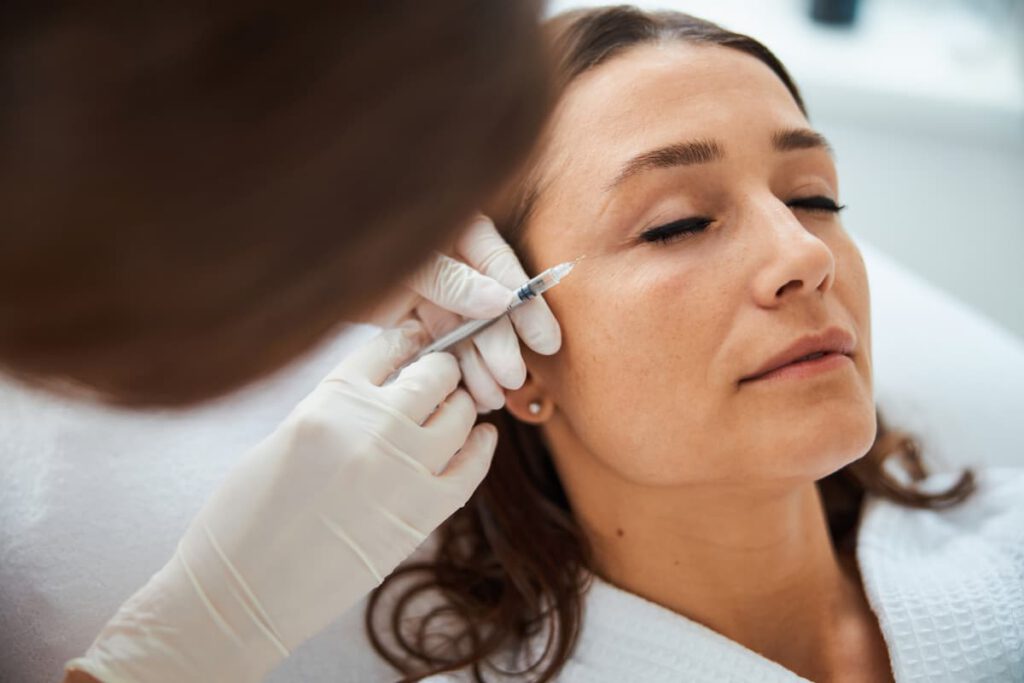Refer a friend, and both you and the person you refer will get $50 off your visit($250 minimum purchase). Learn more!
PRF Gel is here! Smooth fine lines and achieve subtle volume with natural filler. Learn more!

Crow’s feet, those fan-like lines that appear at the outer corners of your eyes, are a common sign of aging. These "smile lines" or eye wrinkles become more visible when you laugh or squint. While some people embrace them, others find crow’s feet a source of self-consciousness. Botox is a popular and effective treatment for these lines.
The Botox procedure for crow’s feet is typically quick and straightforward, usually taking less than 30 minutes. A trained provider uses a fine needle to inject Botox into the muscles around the eyes. The Botox relaxes these muscles, smoothing the overlying skin. While Botox is highly effective, some providers may suggest alternative treatments like dermal fillers, chemical peels, or laser resurfacing for less severe wrinkles.
Crow’s feet are wrinkles that radiate from the corners of the eyes, resembling a bird's claws. Other terms for them include laugh lines, character lines, lateral canthal lines, and periorbital lines.
Compared to other facial lines, crow’s feet often develop earlier due to the delicate nature of the skin around the eyes and the frequent muscle use in this area. Some people may notice crow’s feet as early as their 20s. As we age, these lines become more pronounced, contributing to an older appearance even when other areas of the face are relatively wrinkle-free.
Three main factors contribute to the formation of crow’s feet and other facial wrinkles:
Other dynamic wrinkles include:

While crow’s feet are a natural part of aging, several cosmetic treatments can help reduce their appearance. Botox is a popular choice due to its safety and effectiveness. It is suitable for patients between 25 and 65 years old and can address both mild creases and deeper wrinkles.
Botox is an injectable liquid containing a purified form of botulinum toxin type A. Although botulinum toxin can cause botulism in large amounts, it is perfectly safe when used in small, controlled doses for cosmetic purposes. Botox works by blocking nerve signals from the brain to facial muscles, limiting muscle contractions. For crow’s feet, Botox is injected into the orbicularis oculi muscle around the eyes to relax and smooth the skin.
The ideal Botox dosage for crow’s feet varies from person to person. Because it’s a relatively small treatment area, crow’s feet generally require fewer Botox units. Allergan, the manufacturer of Botox, recommends 24 units (or 6 injections per eye) for optimal results. However, some providers prefer to start conservatively, especially with new patients, using around 10 units per eye. The cost of Botox injections for crow’s feet typically ranges from $300 to $400 per session, depending on the provider and the number of units used.
Botox treatment is not recommended for everyone. It's crucial to consult with an experienced provider, such as a plastic surgeon, to determine your suitability for the procedure. They will evaluate your medical history, current health status, and specific concerns.
Botox is generally not suitable for:
A consultation helps the provider assess your facial anatomy and identify the most appropriate injection sites to achieve the best possible results.
The Botox procedure for crow’s feet is relatively quick and simple. Your provider will typically apply a topical anesthetic or ice to numb the skin around the eye area. Then, using a very fine needle, they will inject Botox into the targeted muscles. The entire procedure usually takes less than 30 minutes. You can typically resume your normal activities immediately afterward, as there is little to no downtime.
Side effects from Botox treatments for crow’s feet are generally uncommon and mild. You may experience temporary side effects at the injection site, such as:
Less common side effects can include:
These side effects typically resolve within 48 hours.
The results of Botox treatment for crow’s feet usually start to become noticeable within three days, with the full effect visible after about two weeks. You can expect to see a significant smoothing of the lines around your eyes when you smile, resulting in a more refreshed and youthful appearance.
However, Botox effects are temporary, typically lasting for 3 to 4 months. To maintain the desired look, many people opt for regular touch-up injections.
Botox may not be suitable for everyone. Fortunately, several alternative non-surgical cosmetic treatments can address crow’s feet and other facial wrinkles:
Evolve Med Spa offers customized treatments to address a wide range of aesthetic concerns, including wrinkles, acne, and blemishes. Our goal is to enhance your natural beauty and help you achieve your desired look.
Our team of board-certified physicians, skilled estheticians, and master injectors is dedicated to providing exceptional care and transformative results. Book an appointment with Evolve Med Spa today.